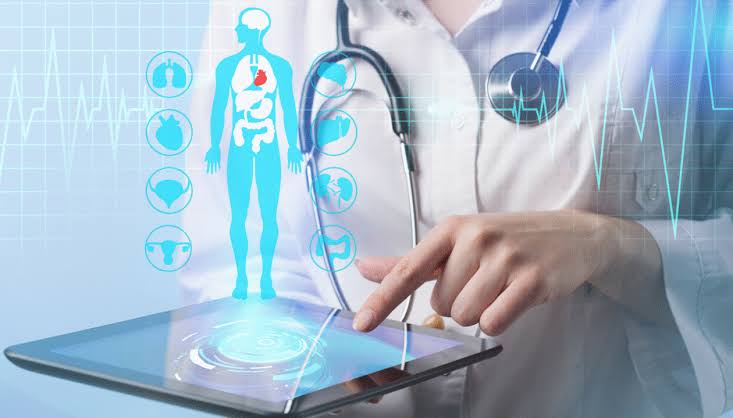
Top Innovations in Healthcare Wearables
Healthcare wearables are transforming personal health management by providing continuous, real-time monitoring of vital signs, activity levels, and wellness metrics. From fitness trackers and smartwatches to advanced biosensors and AI-powered devices, these innovations promote proactive health care and early disease detection. They assist in managing chronic conditions like diabetes, heart disorders, and sleep issues, while also supporting mental health and elderly care. With the integration of
✨ Raghav Jain

Introduction
The intersection of technology and healthcare has produced some of the most revolutionary tools of our time, and one of the most dynamic examples is the rise of healthcare wearables. Once limited to step counters or simple fitness trackers, today’s wearables are intelligent, sensor-packed devices capable of monitoring complex physiological data in real time.
From smartwatches that detect irregular heartbeats to biosensors that monitor glucose levels without needles, wearable health technology is transforming preventive care, diagnostics, treatment, and patient engagement. As chronic diseases continue to rise globally and the demand for remote care grows, wearables are helping both patients and healthcare providers bridge the gap between reactive and proactive health management.The year 2025 marks a pivotal moment in the evolution of healthcare wearables. Building upon years of advancements in sensor technology, artificial intelligence (AI), and miniaturization, the latest innovations are moving beyond basic fitness tracking to offer sophisticated, continuous, and personalized health insights. These cutting-edge devices are empowering individuals to take a more proactive role in their well-being, enabling early detection of health issues, supporting chronic disease management, and fostering a deeper understanding of their own bodies. The top innovations in healthcare wearables in 2025 are characterized by their enhanced accuracy, seamless integration into daily life, and ability to provide actionable data for both users and healthcare professionals.
One of the most significant trends driving innovation in healthcare wearables is the miniaturization and enhanced comfort of devices. Bulky and obtrusive wearables are becoming a thing of the past. The focus is now on creating sleek, discreet devices that users can comfortably wear 24/7 without disrupting their daily routines. The Circular Smart Ring, showcased at CES 2025, exemplifies this trend. This inconspicuous ring packs a powerful suite of health-tracking capabilities, including heart rate variability (HRV) monitoring, sleep stage analysis, blood oxygen level measurement (SpO2), and activity tracking. Its compact design prioritizes both functionality and aesthetics, making it an ideal solution for users seeking continuous health insights in a lightweight and non-intrusive form factor. Similarly, advancements in flexible electronics and smart textiles are leading to the development of sensor-embedded clothing that can seamlessly monitor vital signs like heart rate, respiration rate, and body temperature without the need for traditional wrist-worn devices.
Non-invasive and continuous monitoring of a wider range of physiological parameters is another key area of innovation. Traditionally, measuring certain health metrics required specialized equipment and clinical settings. However, 2025 is witnessing the emergence of wearables capable of providing continuous, cuff-less blood pressure monitoring and non-invasive glucose monitoring. Novosound's ultrasound-based wearable blood pressure monitor, unveiled at CES 2025, represents a significant breakthrough in this area. This device offers the potential for cuff-level accuracy in a comfortable, wearable form factor, revolutionizing hypertension management by enabling real-time tracking and improved user compliance. While fully non-invasive continuous glucose monitoring in wearables is still under development, significant strides are being made with technologies like continuous glucose monitors (CGMs) that provide real-time glucose readings through minimally invasive sensors. These devices are increasingly integrating with smartwatches and other wearables, providing users with a comprehensive view of their glucose trends and enabling timely interventions.
The integration of advanced artificial intelligence (AI) and machine learning (ML) algorithms is significantly enhancing the capabilities of healthcare wearables. AI algorithms can analyze the vast amounts of data collected by these devices to identify subtle patterns and anomalies that may indicate changes in a user's health status. This enables early detection of potential health issues, even before symptoms become apparent. For instance, AI-powered algorithms in wearable ECG monitors can detect irregular heart rhythms like atrial fibrillation with increasing accuracy, prompting users to seek timely medical attention and potentially preventing serious cardiac events. Furthermore, AI is being used to provide personalized insights and recommendations based on an individual's unique health data, activity patterns, and sleep habits, empowering users to make informed lifestyle choices and better manage their well-being.
Wearables designed specifically for women's health are also gaining significant traction in 2025. Devices like Peri, an AI-enabled perimenopause tracker, address a critical gap in healthcare by precisely tracking symptoms and providing tailored insights to women navigating this significant life stage. By monitoring hormonal fluctuations, sleep patterns, and other relevant data, these wearables empower users to manage their health more effectively and promote better overall outcomes. Similarly, advancements in fertility tracking wearables, like the Ava bracelet, continue to provide women with valuable insights into their menstrual cycles, ovulation patterns, and overall reproductive health.
Beyond monitoring and detection, some of the top innovations in healthcare wearables in 2025 are venturing into therapeutic applications. FlowBeams' BoldJet, a laser-powered, needle-free injection device, represents a groundbreaking advancement in medication delivery. This wearable promises to revolutionize clinical and at-home care by offering precise and painless medication administration, enhancing patient comfort and compliance. While still in its early stages, this type of innovation signals a future where wearables could play a more active role in treatment and disease management. Integration with other healthcare technologies and platforms is crucial for unlocking the full potential of healthcare wearables. Seamless connectivity with electronic health records (EHRs), telemedicine platforms, and other digital health tools allows for the secure sharing of data between users and healthcare providers, enabling more informed clinical decision-making and remote patient monitoring. Platforms like Thryve are playing a key role in harmonizing health data from various wearable devices and other sources, providing a unified view of a patient's health information for healthcare professionals. This interoperability is essential for enabling personalized care, facilitating timely interventions, and ultimately improving patient outcomes.
Finally, the increasing focus on user experience and data privacy is shaping the latest innovations in healthcare wearables. Developers are prioritizing intuitive interfaces, clear data visualization, and robust security measures to ensure that users feel comfortable and confident in using these devices and sharing their health information. Transparent data policies and user control over data sharing are becoming increasingly important as the adoption of healthcare wearables continues to grow.
1. Smartwatches with Advanced Health Monitoring
Modern smartwatches are no longer just for counting steps or checking notifications. Brands like Apple, Samsung, Fitbit, and Garmin have turned smartwatches into portable health labs on the wrist.
Key innovations include:
- ECG Monitoring: Apple Watch and others offer electrocardiogram capabilities that detect atrial fibrillation and other arrhythmias.
- Blood Oxygen (SpO2) Monitoring: Useful during COVID-19 for tracking respiratory health.
- Fall Detection and Emergency Alerts: Ideal for elderly users or those at risk of falls.
- Continuous Heart Rate Monitoring: Detects irregularities and stress levels.
These smartwatches are being used in clinical research, cardiac care, and even remote patient monitoring programs to provide continuous, real-world data.
2. Continuous Glucose Monitors (CGMs)
One of the most life-changing advancements in wearables has been the Continuous Glucose Monitor (CGM) for people with diabetes.
Notable innovations:
- Non-invasive or minimally invasive sensors that track blood glucose 24/7
- Real-time alerts to avoid hypoglycemia or hyperglycemia
- Seamless integration with insulin pumps for automated insulin delivery
- Smartphone connectivity for tracking and sharing data with caregivers or doctors
Brands like Dexcom, Abbott (FreeStyle Libre), and Medtronic are leading this transformation, making diabetes management simpler and safer.
3. Wearable Blood Pressure Monitors
Traditional blood pressure cuffs can be bulky and inconvenient. New wearable tech now allows users to monitor blood pressure throughout the day without interrupting their routine.
Key features:
- Cuffless technology using optical sensors and pulse wave analysis
- Integration into smartwatches (like the Samsung Galaxy Watch)
- On-demand or continuous monitoring
- Data storage and sharing with healthcare providers
These wearables are especially useful for managing hypertension, which often goes undiagnosed due to inconsistent monitoring.
4. Smart Rings for Health Tracking
Smart rings are a sleek alternative to wrist-based wearables, packing powerful sensors into a discreet design.
Popular examples include the Oura Ring and Movano Ring, which offer features like:
- Sleep tracking with precision
- Resting heart rate and HRV (heart rate variability)
- Temperature variation tracking for illness detection or menstrual cycle predictions
- Activity tracking and recovery analysis
Their small size and long battery life make smart rings ideal for people seeking low-profile yet powerful health wearables.
5. Biosensor Patches
Biosensor patches are thin, flexible devices that stick to the skin and measure everything from hydration to electrolyte levels, sweat composition, and muscle performance.
Applications include:
- Post-operative monitoring for infection or vital signs
- Athlete performance tracking
- Remote patient monitoring in chronic care
Companies like VitalConnect and Philips are developing FDA-approved biosensor patches that stream real-time data directly to physicians or mobile apps.
6. Wearables for Respiratory Monitoring
With the increased focus on respiratory health, particularly during and after the COVID-19 pandemic, wearables have emerged that monitor lung function, oxygen intake, and breathing patterns.
Examples include:
- Asthma monitoring devices like Propeller Health, which track inhaler usage and respiratory patterns
- Respiratory wearables for detecting early signs of COPD or sleep apnea
- Wearable spirometers for at-home pulmonary function testing
These innovations are key in early detection, treatment adherence, and remote care of respiratory conditions.
7. Wearables for Mental Health Monitoring
Mental health is just as critical as physical health, and wearable technology is now being used to detect emotional changes, stress levels, and even potential depressive episodes.
Key developments include:
- Stress tracking via heart rate variability (HRV) and skin temperature
- Mood detection using voice patterns and facial expression sensors
- Sleep pattern monitoring to detect early signs of anxiety or insomnia
Devices like Embrace2 (from Empatica) are FDA-cleared for seizure detection and also aid in tracking stress and emotional states, making them useful for users with epilepsy or mental health conditions.
8. Smart Clothing and E-Textiles
Healthcare wearables are also moving into fashion through smart fabrics embedded with sensors that collect and transmit health data.
Examples include:
- Shirts or bras that track heart rate, respiration, and movement
- Socks with sensors for diabetic foot monitoring or fall risk detection
- Fitness clothing that measures muscle activity and form
Brands like Hexoskin, Nadi X, and Sensoria are making this cutting-edge tech more accessible and stylish, pushing wearables into everyday fashion.
9. Fall Detection and Mobility Trackers for Seniors
Elderly care is a significant area where wearables are making a difference by providing safety, independence, and peace of mind.
Features of such devices:
- Fall detection with automatic emergency alerts
- GPS tracking for wandering prevention in dementia patients
- Activity reminders and medication alerts
- Balance and gait analysis for fall prevention
Wearables like Lively Mobile Plus, Medical Guardian, and Kanega Watch offer life-saving support for aging populations, enabling more secure independent living.
10. AI-Powered Wearable Analytics
One of the most groundbreaking innovations is the integration of AI and machine learning into wearable platforms. These algorithms analyze vast amounts of health data to deliver personalized insights and predictive alerts.
What AI-powered wearables can do:
- Detect arrhythmias, sleep apnea, or seizures before symptoms occur
- Predict injuries based on muscle strain patterns
- Provide lifestyle coaching based on real-time biometric data
- Enable early intervention and predictive diagnostics
Wearable makers like WHOOP and Fitbit Premium offer AI-based health coaching, recovery scores, and advanced trend analysis that’s revolutionizing health management.
The Role of Wearables in Remote Patient Monitoring (RPM)
One of the biggest shifts in healthcare delivery is the rise of Remote Patient Monitoring (RPM). Wearables are at the heart of this transformation, allowing doctors to monitor patients' vitals in real time without hospital visits.
Benefits of RPM using wearables:
- Reduced hospital readmissions
- Improved care for chronic illnesses like diabetes, hypertension, and heart disease
- Early detection of complications or emergencies
- Greater patient engagement and compliance
Government bodies like Medicare are even providing reimbursements for RPM programs, boosting adoption in mainstream care.
Challenges and Considerations
While wearables offer remarkable potential, they also come with challenges:
- Privacy and data security: Health data must be securely stored and transmitted
- Device accuracy: Variability in readings can lead to false positives or negatives
- User compliance: Devices are only effective if consistently worn and synced
- Integration into healthcare systems: Physicians need proper tools to analyze and interpret wearable data
Overcoming these hurdles is crucial for maximizing the benefits of wearable tech.
Conclusion
From smartwatches that detect heart conditions to biosensors that monitor glucose without a single needle, healthcare wearables are revolutionizing the way we approach health. These technologies empower individuals to take control of their well-being, assist doctors with real-time diagnostics, and ultimately promote a shift from reactive to preventive and personalized care.
As innovation continues, we can expect wearables to become smaller, smarter, and more integrated into our daily lives. They will not only help us live longer but live healthier and more informed lives. Whether you're a patient, caregiver, or healthcare professional, embracing the power of wearables could be one of the smartest steps toward a healthier future.
Q&A Section: Top Innovations in Healthcare Wearables
Q1: What are healthcare wearables and how do they work?
Ans: Healthcare wearables are smart electronic devices worn on the body that monitor health data like heart rate, sleep, activity levels, and more. They use sensors and wireless connectivity to track, store, and share health information.
Q2: How do fitness trackers contribute to personal health management?
Ans: Fitness trackers help users monitor physical activities, steps, calories burned, and sleep patterns. They encourage healthier lifestyles by setting fitness goals and providing real-time feedback.
Q3: What role do smartwatches play in healthcare innovation?
Ans: Smartwatches combine traditional watch features with health-monitoring functions like heart rate tracking, ECG, blood oxygen levels, and even fall detection, offering 24/7 wellness tracking.
Q4: How do continuous glucose monitors (CGMs) help diabetic patients?
Ans: CGMs are wearable devices that track glucose levels in real time, alerting users to highs or lows, thus helping diabetics manage their blood sugar without frequent finger pricks.
Q5: What are wearable ECG monitors and why are they important?
Ans: Wearable ECG monitors continuously record heart rhythms, enabling early detection of arrhythmias and other cardiac issues, thus reducing the risk of heart-related complications.
Q6: How is wearable technology used in sleep tracking?
Ans: Wearables track sleep stages, movement, and breathing patterns, helping users identify sleep disorders and improve sleep quality with personalized insights.
Q7: What are biosensor patches and what do they monitor?
Ans: Biosensor patches are adhesive devices placed on the skin to monitor vitals like temperature, hydration, respiratory rate, and muscle activity in real-time.
Q8: How are wearables helping with mental health monitoring?
Ans: Some wearables track stress levels through heart rate variability and skin conductivity. They offer breathing exercises and mindfulness alerts to promote emotional well-being.
Q9: What is the impact of wearable tech on elderly care?
Ans: Wearables help elderly individuals monitor their health independently, with features like fall detection, medication reminders, and emergency alerts for caregivers or family.
Q10: What is the future potential of AI-powered healthcare wearables?
Ans: AI-powered wearables can predict health issues by analyzing trends and anomalies in collected data, offering proactive care, early diagnosis, and personalized health recommendations.
Similar Articles
Find more relatable content in similar Articles

The Role of AI Facial Recognit..
AI facial recognition is revo.. Read More

Top AI Applications for Design..
AI is revolutionizing social .. Read More

Hyperloop Technology: A Game-..
Hyperloop technology envision.. Read More

How Wearable Devices Detect Hu..
Wearable devices use biosenso.. Read More
Explore Other Categories
Explore many different categories of articles ranging from Gadgets to Security
Smart Devices, Gear & Innovations
Discover in-depth reviews, hands-on experiences, and expert insights on the newest gadgets—from smartphones to smartwatches, headphones, wearables, and everything in between. Stay ahead with the latest in tech gear
Apps That Power Your World
Explore essential mobile and desktop applications across all platforms. From productivity boosters to creative tools, we cover updates, recommendations, and how-tos to make your digital life easier and more efficient.
Tomorrow's Technology, Today's Insights
Dive into the world of emerging technologies, AI breakthroughs, space tech, robotics, and innovations shaping the future. Stay informed on what's next in the evolution of science and technology.
Protecting You in a Digital Age
Learn how to secure your data, protect your privacy, and understand the latest in online threats. We break down complex cybersecurity topics into practical advice for everyday users and professionals alike.
© 2025 Copyrights by rTechnology. All Rights Reserved.